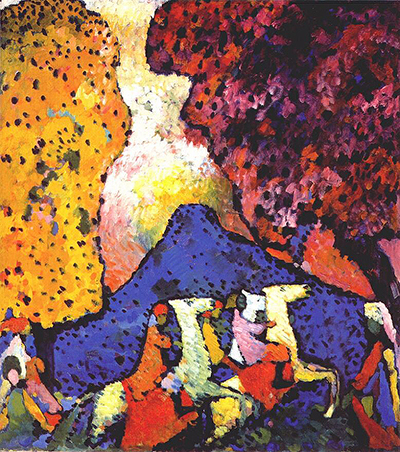Blue Mountain is just one of a number of expressive landscape scenes created by Wassily Kandinsky across his career. We are all aware of The Blue Rider, well this painting again features horses striding across the countryside.
Kandinsky studied colour in great detail in the early stages of his artistic development and he would later write several publications about his own theories on this topic. The result of all this is that he became one of the most skilled artists in the application of colour within western art and Blue Mountain provides an example of this. The artwork was completed in 1908–09 in his customary oils. He makes use of yellows, reds, browns, whites and blues in order to produce this eye catching, charming piece. Most of the colours are adapted into darker and lighter tones which provides a deeper palette. The initial focus is drawn to the two trees which drift in from either side of the cropped composition. We then view the blue mountain in the centre, with a carefully crafted sky behind them which purposely uses the tones from the rest of the painting and blends them into a foundation of white - this creates a consistency between the sky and the rest of the landscape.
Many have argued that the horse and rider combination that can be found in a number of his paintings was not simply a brand or form of iconography for purely aesthetic purposes. In reality, it was used to represent Kandinsky's aggressive stance against traditional art, which he found stale and in need of updating. Most of the academics of the time were opposed to this view, but over time he at least persuaded them to listen to his opinions and at the very least find and appreciate the qualities found within more modern art. In this particular painting there are two horse and riders in the centre of the composition, and then a flurry of other figures to the left and right of them to provide additional visual support. When we consider the popular works from his career, there is an equal blend between the truly abstract, and then items like this where the key elements can be easily identified.
1909 marked the arrival of this painting, as well as another seven related artworks which also included this Horse and Rider combination. It was clearly very much in his mind at that time, with Kandinsky aged in his early forties at that time. He was perhaps at his height in terms of balancing youthful revolution with the confidence of having an established career. This important period in his development marked a point at which this symbol that he used repeatedly was intended to symbolise the Horsemen of the Apocalypse. His work also was on a course towards greater abstraction, though this would fluctuate in both directions throughout his lifetime. His use of inspiration from the Revelation of Saint John the Divine can be considered a religious phase which then drifted away later on.




 in Detail Wassily Kandinsky.jpg)
